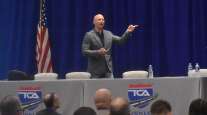EPA Asks Court to Dismiss Navistar Lawsuit Over SCR Engine-Emissions Testing Methods
This story appears in the Sept. 19 print edition of Transport Topics.
The Environmental Protection Agency has asked a federal court to dismiss a Navistar Inc. lawsuit seeking to require that the agency test selective catalytic reduction engines with the emissions systems disabled or used improperly.
Navistar, maker of International trucks and MaxxForce engines, contends that SCR emissions systems used by all other heavy-duty engine makers in the United States can be foiled by running them with water instead of diesel exhaust fluid, a urea solution that enables the system’s catalytic converter to remove nitrogen oxides.
Navistar trucks do not use SCR, but rather have engines that remove NOx with exhaust gas recirculation exclusively.
In its Sept. 9 motion, EPA said federal law gives the agency’s administrator “discretion to decide the appropriate manner of testing” and that Navistar is asking the federal court to “intrude into the administrator’s exercise of discretion.”
“EPA has certified several engine families that use SCR technology and has not required that these engines be tested without DEF, as long as the manufacturer demonstrates to EPA that its engines are designed with appropriate strategies (e.g., warning lights, engine derates) to make operation without DEF unlikely,” EPA said.
Navistar filed its lawsuit in federal court in the District of Columbia on July 5, more than a year after the company dropped a similar 2009 lawsuit after reaching a settlement agreement with EPA (7-18, p. 3).
Navistar alleged in its July lawsuit that EPA Administrator Lisa Jackson failed to require testing of the SCR engines under “actual current driving conditions.”
“EPA has turned a willful blind eye to SCR non-compliance,” Navistar said in its lawsuit.
Navistar said the agency must test selective catalytic reduction engines with their SCR system turned off, running without diesel exhaust fluid and running with water instead of diesel exhaust fluid.
The Navistar lawsuit also sought to block EPA’s recently updated guidance for certification of heavy-duty truck engines using SCR to reduce emissions.
A Navistar spokesman declined to comment on EPA’s motion.
In June, EPA issued the updated SCR certification guidance, denying Navistar’s persistent claims that the technology can be easily defeated (6-13, p. 1).
Navistar based its claims on a study it commissioned last year that it said showed SCR trucks could run for thousands of miles even when their DEF reservoirs are empty or filled with tap water (7-26-10, p. 1).
But in issuing its most recent revised guidance, EPA said the SCR technology has proven effective in testing, with no indications of any widespread driver tampering with the technology. However, the agency urged SCR engine manufacturers to continue improving warning systems that alert drivers when a truck’s DEF is low or empty, or filled with “incorrect or poor-quality agent.”
NOx emissions can increase substantially without DEF in the tank.
In its motion to dismiss, EPA said that Navistar has asked the federal court to order EPA to test the SCR engines “in the manner deemed appropriate by Navistar.”
“Regardless of how Navistar words its allegations, the substance of its complaint is that the administrator erred in exercising her discretionary authority to decide which tests were appropriate for determining whether SCR engines conform to the required emission standards,” EPA said.
SCR engine manufacturers also have defended their emissions reduction technology in written comments to EPA’s June updated guidance.
The manufacturers using SCR include engine manufacturer Cummins Inc.; Daimler Trucks North America and its engine subsidiary, Detroit Diesel Corp.; Volvo Trucks North America; Mack Trucks, and Paccar Inc.




